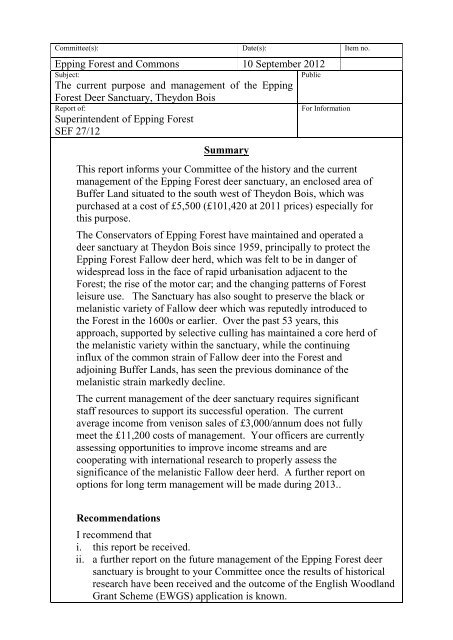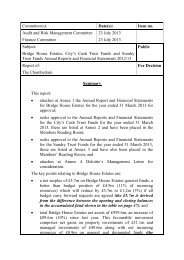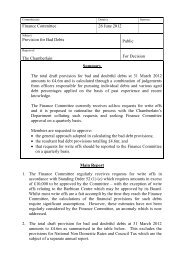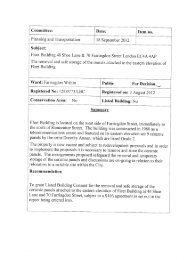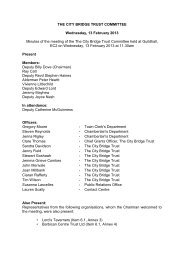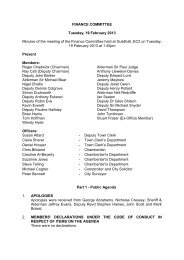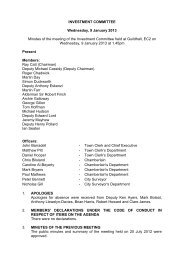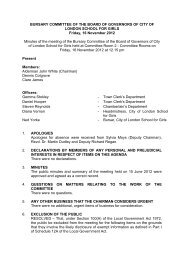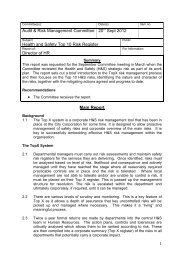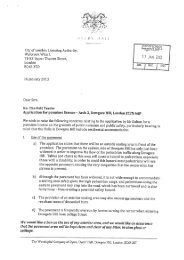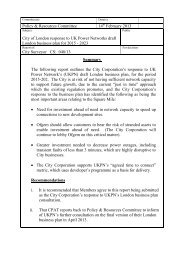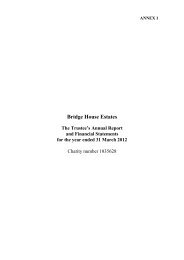The current purpose and management of the Epping Forest Deer ...
The current purpose and management of the Epping Forest Deer ...
The current purpose and management of the Epping Forest Deer ...
Create successful ePaper yourself
Turn your PDF publications into a flip-book with our unique Google optimized e-Paper software.
Committee(s): Date(s): Item no.<br />
<strong>Epping</strong> <strong>Forest</strong> <strong>and</strong> Commons 10 September 2012<br />
Subject:<br />
Public<br />
<strong>The</strong> <strong>current</strong> <strong>purpose</strong> <strong>and</strong> <strong>management</strong> <strong>of</strong> <strong>the</strong> <strong>Epping</strong><br />
<strong>Forest</strong> <strong>Deer</strong> Sanctuary, <strong>The</strong>ydon Bois<br />
Report <strong>of</strong>:<br />
Superintendent <strong>of</strong> <strong>Epping</strong> <strong>Forest</strong><br />
SEF 27/12<br />
Summary<br />
For Information<br />
This report informs your Committee <strong>of</strong> <strong>the</strong> history <strong>and</strong> <strong>the</strong> <strong>current</strong><br />
<strong>management</strong> <strong>of</strong> <strong>the</strong> <strong>Epping</strong> <strong>Forest</strong> deer sanctuary, an enclosed area <strong>of</strong><br />
Buffer L<strong>and</strong> situated to <strong>the</strong> south west <strong>of</strong> <strong>The</strong>ydon Bois, which was<br />
purchased at a cost <strong>of</strong> £5,500 (£101,420 at 2011 prices) especially for<br />
this <strong>purpose</strong>.<br />
<strong>The</strong> Conservators <strong>of</strong> <strong>Epping</strong> <strong>Forest</strong> have maintained <strong>and</strong> operated a<br />
deer sanctuary at <strong>The</strong>ydon Bois since 1959, principally to protect <strong>the</strong><br />
<strong>Epping</strong> <strong>Forest</strong> Fallow deer herd, which was felt to be in danger <strong>of</strong><br />
widespread loss in <strong>the</strong> face <strong>of</strong> rapid urbanisation adjacent to <strong>the</strong><br />
<strong>Forest</strong>; <strong>the</strong> rise <strong>of</strong> <strong>the</strong> motor car; <strong>and</strong> <strong>the</strong> changing patterns <strong>of</strong> <strong>Forest</strong><br />
leisure use. <strong>The</strong> Sanctuary has also sought to preserve <strong>the</strong> black or<br />
melanistic variety <strong>of</strong> Fallow deer which was reputedly introduced to<br />
<strong>the</strong> <strong>Forest</strong> in <strong>the</strong> 1600s or earlier. Over <strong>the</strong> past 53 years, this<br />
approach, supported by selective culling has maintained a core herd <strong>of</strong><br />
<strong>the</strong> melanistic variety within <strong>the</strong> sanctuary, while <strong>the</strong> continuing<br />
influx <strong>of</strong> <strong>the</strong> common strain <strong>of</strong> Fallow deer into <strong>the</strong> <strong>Forest</strong> <strong>and</strong><br />
adjoining Buffer L<strong>and</strong>s, has seen <strong>the</strong> previous dominance <strong>of</strong> <strong>the</strong><br />
melanistic strain markedly decline.<br />
<strong>The</strong> <strong>current</strong> <strong>management</strong> <strong>of</strong> <strong>the</strong> deer sanctuary requires significant<br />
staff resources to support its successful operation. <strong>The</strong> <strong>current</strong><br />
average income from venison sales <strong>of</strong> £3,000/annum does not fully<br />
meet <strong>the</strong> £11,200 costs <strong>of</strong> <strong>management</strong>. Your <strong>of</strong>ficers are <strong>current</strong>ly<br />
assessing opportunities to improve income streams <strong>and</strong> are<br />
cooperating with international research to properly assess <strong>the</strong><br />
significance <strong>of</strong> <strong>the</strong> melanistic Fallow deer herd. A fur<strong>the</strong>r report on<br />
options for long term <strong>management</strong> will be made during 2013..<br />
Recommendations<br />
I recommend that<br />
i. this report be received.<br />
ii. a fur<strong>the</strong>r report on <strong>the</strong> future <strong>management</strong> <strong>of</strong> <strong>the</strong> <strong>Epping</strong> <strong>Forest</strong> deer<br />
sanctuary is brought to your Committee once <strong>the</strong> results <strong>of</strong> historical<br />
research have been received <strong>and</strong> <strong>the</strong> outcome <strong>of</strong> <strong>the</strong> English Woodl<strong>and</strong><br />
Grant Scheme (EWGS) application is known.
Main Report<br />
Background<br />
1. Fallow deer (Dama dama) are known to have been present in <strong>the</strong> Royal<br />
<strong>Forest</strong> <strong>of</strong> Waltham, <strong>of</strong> which <strong>Epping</strong> <strong>Forest</strong> was a part, since <strong>the</strong> late<br />
Middle Ages. Fallow deer have several forms which are defined by <strong>the</strong>ir<br />
coat colour, referred to as a pelage. Typical colours include <strong>the</strong>:<br />
i. common – a tawny yellow colour dappled with spots – <strong>the</strong> source<br />
<strong>of</strong> <strong>the</strong> „fallow‟ name;<br />
ii. brown;<br />
iii. melanistic - black;<br />
iv. menil - a paler version <strong>of</strong> <strong>the</strong> common form;<br />
v. blue - essentially a grey form <strong>and</strong><br />
vi. Leucistic - white (but not abino).<br />
2. Traditionally, <strong>the</strong> preponderance <strong>of</strong> particular pelage colours in herds was<br />
thought to reflect <strong>the</strong> emergence <strong>of</strong> particular strains or races which are<br />
genetically stable. Recent research suggests pelage colour does not breed<br />
true <strong>and</strong> that genetic isolation through imparking <strong>and</strong> <strong>the</strong> culling<br />
preferences <strong>of</strong> park owners may play a more significant role in <strong>the</strong><br />
emergence <strong>of</strong> a dominant pelage colour.<br />
3. <strong>The</strong> history <strong>of</strong> Fallow deer in <strong>Epping</strong> <strong>Forest</strong> is well documented by<br />
Verderers‟ Court Records; observations by historical commentators <strong>and</strong><br />
regular reports to your Committee during <strong>the</strong> City <strong>of</strong> London‟s stewardship.<br />
Over time significant comment has been reserved for what was considered<br />
to be <strong>Epping</strong> <strong>Forest</strong>‟s famous black or melanistic deer herd.<br />
4. At outlined in a short history in Appendix 1, <strong>the</strong>re is some evidence to<br />
suggest that <strong>the</strong> melanistic herd at <strong>Epping</strong> <strong>Forest</strong> was established from a<br />
Norwegian variety <strong>of</strong> Fallow deer introduced by James I. This melanistic<br />
variety has been romantically identified by some observers as „<strong>the</strong> old<br />
<strong>Forest</strong> breed‟ <strong>of</strong> Fallow deer. Heavy poaching had reduced deer numbers<br />
from a typical range <strong>of</strong> 300-400 in <strong>the</strong> medieval Royal <strong>Forest</strong> to just 10 by<br />
1860 <strong>and</strong> 13 in 1878. Under <strong>the</strong> Conservator‟s control numbers grew to<br />
270 by 1902, but fell st<strong>and</strong>ing at around 150 for <strong>the</strong> first half <strong>of</strong> <strong>the</strong> 20 th<br />
Century.<br />
5. Although <strong>the</strong> original reports outlining <strong>the</strong> reasons for <strong>the</strong> decline in deer<br />
numbers have been lost, Superintendent Alfred Qvist writing in 1971<br />
pointed to <strong>the</strong> movement <strong>of</strong> deer away from <strong>the</strong> <strong>Forest</strong> woodl<strong>and</strong>s to <strong>the</strong><br />
quieter estate woodl<strong>and</strong>s North <strong>of</strong> <strong>the</strong> <strong>Forest</strong>. This was attributed to <strong>the</strong><br />
growing urbanisation <strong>of</strong> <strong>the</strong> areas surrounding <strong>Epping</strong> <strong>Forest</strong> <strong>and</strong> <strong>the</strong><br />
changing pattern <strong>of</strong> visitor use, especially <strong>the</strong> growth <strong>of</strong> dog walking,<br />
toge<strong>the</strong>r with <strong>the</strong> growth <strong>of</strong> motor cars <strong>and</strong> <strong>the</strong> consequent increase in <strong>Deer</strong><br />
Vehicles Collisions (DVCs) on local roads.
6. By 1954, a significant decline in <strong>the</strong> <strong>Epping</strong> deer population to 67 animals<br />
had prompted your Committee to consider a series <strong>of</strong> contingency plans<br />
including <strong>the</strong> creation by gift <strong>of</strong> a second melanistic deer herd at<br />
Whipsnade in 1956 <strong>and</strong> <strong>the</strong> purchase in 1959 <strong>of</strong> 35 hectares (88 acres) <strong>of</strong><br />
l<strong>and</strong> at <strong>The</strong>ydon Bois to form a dedicated deer sanctuary. A fur<strong>the</strong>r 9<br />
hectares (24 acres) <strong>of</strong> woodl<strong>and</strong>, would eventually be combined with <strong>the</strong><br />
deer sanctuary in 1980. See appendix 2.<br />
7. At <strong>the</strong> same time <strong>the</strong>re was a wider discussion in post-war Britain regarding<br />
<strong>the</strong> growth <strong>of</strong> <strong>the</strong> „Leisure Society‟ <strong>and</strong> <strong>the</strong> new pressures this would bring<br />
to <strong>the</strong> Countryside, Michael Dower writing in „<strong>The</strong> Fourth Wave‟ (1965)<br />
warned <strong>of</strong> a „wave‟ <strong>of</strong> leisure following industrialisation; railways <strong>and</strong> carbased<br />
suburbs driven by a „battalion <strong>of</strong> cars‟. Such dystopian prophecies<br />
undoubtedly reinforced <strong>the</strong> importance <strong>of</strong> a deer sanctuary away from <strong>the</strong><br />
<strong>Forest</strong>‟s obligations to <strong>the</strong> new age <strong>of</strong> leisure.<br />
8. What is less well understood is whe<strong>the</strong>r <strong>the</strong> concerns <strong>of</strong> <strong>the</strong> time related to<br />
<strong>the</strong> entire loss <strong>of</strong> deer from <strong>the</strong> <strong>Forest</strong> or fundamentally <strong>the</strong> loss <strong>of</strong> <strong>the</strong><br />
melanistic bloodline particularly associated with <strong>Epping</strong> <strong>Forest</strong>.<br />
9. A significant component <strong>of</strong> <strong>the</strong> <strong>management</strong> <strong>of</strong> <strong>the</strong> deer sanctuary is <strong>the</strong><br />
wide ranging restrictions on public access. <strong>The</strong>se restrictions were created<br />
to protect <strong>the</strong> deer from <strong>the</strong> concerns <strong>of</strong> <strong>the</strong> time <strong>and</strong> <strong>the</strong> necessity to<br />
purchase l<strong>and</strong> that could be operated outside <strong>the</strong> <strong>Epping</strong> <strong>Forest</strong> Acts 1878<br />
<strong>and</strong> 1880. In placing <strong>the</strong> deer sanctuary outside <strong>the</strong> stated <strong>purpose</strong>s <strong>of</strong> <strong>the</strong><br />
Acts, <strong>the</strong> continued operation <strong>of</strong> <strong>the</strong> <strong>current</strong> arrangements will create<br />
challenges for <strong>the</strong> Conservators with regard to its legal status.<br />
Current Position<br />
10. <strong>The</strong> <strong>management</strong> <strong>of</strong> <strong>the</strong> sanctuary requires a significant level <strong>of</strong> staff<br />
resources to be made available. An annual cull is set in order to maintain<br />
herd size, sex ratio <strong>and</strong> to control any deer born with alternative colouring<br />
to <strong>the</strong> preferred black (melanistic) colour type. <strong>The</strong> annual cull for a herd <strong>of</strong><br />
100 needs to be in <strong>the</strong> order <strong>of</strong> 40 animals (Langbein 1996), <strong>and</strong> as stated in<br />
<strong>the</strong> 9 July 2012 report to your Committee (<strong>Deer</strong> Management on <strong>the</strong> Buffer<br />
l<strong>and</strong>s) each deer culled requires 0.5 staff days.<br />
11. Welfare checks on <strong>the</strong> herd are to be carried out at least every o<strong>the</strong>r day <strong>and</strong><br />
periodic checks on <strong>the</strong> integrity <strong>of</strong> <strong>the</strong> perimeter fence are essential. Staff<br />
are also required to carry out supplementary feeding <strong>of</strong> <strong>the</strong> deer, from<br />
September through until <strong>the</strong> end <strong>of</strong> March, depending on <strong>the</strong> wea<strong>the</strong>r<br />
conditions, usually being three times a week. <strong>The</strong>re is also a requirement<br />
for some grassl<strong>and</strong> <strong>management</strong> to take place in <strong>the</strong> form <strong>of</strong> grass topping,<br />
harrowing <strong>and</strong> rolling, this can be carried out by in house staff if resources<br />
allow o<strong>the</strong>rwise contractors need to be engaged to carry out <strong>the</strong> works.
12. Currently <strong>the</strong> post cull herd in <strong>the</strong> sanctuary is approximately 140 head plus<br />
a fawn drop <strong>of</strong> approximately 35. It is difficult to obtain an accurate count<br />
as <strong>the</strong> herd tends to form into large groups whenever approached or<br />
stressed (Langbein 1996). <strong>The</strong> <strong>current</strong> <strong>management</strong> <strong>of</strong> <strong>the</strong> deer sanctuary is<br />
<strong>the</strong> responsibility <strong>of</strong> <strong>the</strong> Head <strong>Forest</strong> Keeper <strong>and</strong> <strong>the</strong> day to day<br />
<strong>management</strong> is carried out by a <strong>Forest</strong> Keeper from <strong>the</strong> Nor<strong>the</strong>rn team who<br />
have specialist skills in this area. <strong>The</strong> Keeper is assisted with winter<br />
feeding, fence checking <strong>and</strong> o<strong>the</strong>r tasks by <strong>the</strong> Nor<strong>the</strong>rn <strong>Forest</strong> Keepers or<br />
o<strong>the</strong>r <strong>Forest</strong> Keepers as required.<br />
13. <strong>The</strong> annual cull within <strong>the</strong> sanctuary is set by <strong>the</strong> Head <strong>Forest</strong> Keeper <strong>and</strong><br />
<strong>the</strong> <strong>current</strong> aim is to reduce <strong>the</strong> herd size back to 100 head post cull as<br />
previously agreed by your Committee following <strong>the</strong> recommendations in a<br />
report commissioned in 1996 (Langbein 1996). This would require an<br />
annual cull in 2012/13 <strong>of</strong> 75 deer which would be difficult to achieve in a<br />
single year. <strong>The</strong> cull <strong>of</strong> 62 deer carried out in 2011/12 was probably as high<br />
as can be realistically achieved with <strong>the</strong> resources available. <strong>The</strong>refore a<br />
cull <strong>of</strong> a minimum <strong>of</strong> sixty has been set for this year with <strong>the</strong> surplus being<br />
taken in <strong>the</strong> 2013/14 cull.<br />
14. <strong>The</strong> annual cull is <strong>current</strong>ly carried out by two Nor<strong>the</strong>rn <strong>Forest</strong> Keepers<br />
who are fully qualified <strong>and</strong> trained to carry out <strong>the</strong> task. <strong>The</strong> City <strong>of</strong><br />
London supplies Keepers with <strong>the</strong> necessary equipment <strong>and</strong> an agreed<br />
programme <strong>of</strong> training enabling <strong>the</strong>m to carry out this task in a pr<strong>of</strong>essional<br />
<strong>and</strong> humane manner. <strong>Epping</strong> <strong>Forest</strong> does not have any in-house chiller<br />
facilities to store <strong>the</strong> carcasses resulting from <strong>the</strong> cull. Cold storage is<br />
provided by <strong>the</strong> use <strong>of</strong> a chiller owned by one <strong>of</strong> <strong>the</strong> <strong>Forest</strong> Keepers that<br />
carry out <strong>the</strong> cull in <strong>the</strong> sanctuary. <strong>The</strong> chiller is registered with <strong>the</strong> local<br />
Environmental Health <strong>and</strong> is inspected by <strong>the</strong>m on a regular basis.<br />
15. A study <strong>of</strong> <strong>the</strong> DNA <strong>of</strong> <strong>the</strong> deer within <strong>the</strong> sanctuary is <strong>current</strong>ly being<br />
carried out as part <strong>of</strong> a study funded by Arts <strong>and</strong> Humanities Research<br />
Council through Nottingham <strong>and</strong> Durham Universities into <strong>the</strong> origin <strong>of</strong><br />
Historical Fallow deer herds in European Society 6000 BC – 1600 AD.<br />
Tongue tip samples from deer culled during 2011/12 <strong>and</strong> from <strong>the</strong><br />
forthcoming 2012/13 cull are sent <strong>of</strong>f for DNA analysis. <strong>The</strong> reason for<br />
using <strong>the</strong> tip <strong>of</strong> <strong>the</strong> tongue is that only one sample can be sent from each<br />
deer, <strong>the</strong>re is no chance <strong>of</strong> replication. <strong>The</strong> initial outcome <strong>of</strong> this study<br />
should be presented in March 2013.<br />
16. A visit to Whipsnade Zoo has taken place <strong>and</strong> found that <strong>the</strong> small herd <strong>of</strong><br />
black fallow have been retained as a pure bred herd from <strong>the</strong> original<br />
1955/6 deer presented to <strong>the</strong>m. A return visit <strong>the</strong> sanctuary at <strong>The</strong>ydon Bois<br />
by Whipsnade staff is proposed <strong>and</strong> it is hoped that <strong>the</strong>y will also<br />
participate in <strong>the</strong> Nottingham <strong>and</strong> Durham Universities study to help find<br />
out if indeed <strong>the</strong> deer are a true old established strain <strong>of</strong> melanistic Fallow<br />
deer.
17. Melanistic deer herds are also found at Haldon <strong>Forest</strong> Park, Devon; Levens<br />
Hall Park, Cumbria; Parham Estate, West Sussex; <strong>The</strong> Trentham Estate,<br />
Staffordshire; Packington Estate, Warwickshire; Powderham Castle,<br />
Devon; Raby Castle, County Durham.<br />
18. Gaunt‟s Wood <strong>and</strong> Red Oak Wood, two areas <strong>of</strong> woodl<strong>and</strong> within <strong>the</strong><br />
sanctuary which have been fenced <strong>of</strong>f since <strong>the</strong>ir replanting are included in<br />
<strong>the</strong> proposed EWGS application which is <strong>the</strong> subject <strong>of</strong> ano<strong>the</strong>r report to<br />
your Committee 10 September 2012. <strong>The</strong> scheme would see a controlled<br />
reintroduction <strong>of</strong> <strong>the</strong> deer herd into <strong>the</strong>se areas.<br />
19. Although <strong>the</strong>re is no public access to <strong>the</strong> sanctuary <strong>Forest</strong> Keepers<br />
regularly accompany groups <strong>and</strong> individuals on guided tours, about 25<br />
groups in 2011. <strong>The</strong>re is also a dem<strong>and</strong> for <strong>the</strong> filming <strong>and</strong> photography<br />
opportunities <strong>the</strong> sanctuary can <strong>of</strong>fer; not only <strong>of</strong> <strong>the</strong> deer but o<strong>the</strong>r wildlife<br />
as it is virtually undisturbed due to <strong>the</strong> limited access.<br />
Options<br />
20. <strong>The</strong>re are a number <strong>of</strong> options available to your Committee ranging from<br />
closure <strong>of</strong> <strong>the</strong> sanctuary to <strong>the</strong> maintenance <strong>of</strong> its operation with different<br />
levels <strong>of</strong> herd numbers. As information regarding <strong>the</strong> significance <strong>of</strong> <strong>the</strong><br />
<strong>current</strong> melanistic herd is not available, it is suggested that <strong>the</strong> <strong>current</strong><br />
<strong>management</strong> approach is maintained until <strong>the</strong> <strong>management</strong> objective for <strong>the</strong><br />
deer sanctuary can be more clearly articulated.<br />
Proposals<br />
21. I <strong>the</strong>refore propose that <strong>the</strong> <strong>current</strong> <strong>management</strong> <strong>of</strong> <strong>the</strong> deer sanctuary be<br />
continued until such time that <strong>the</strong> results <strong>of</strong> <strong>the</strong> comparative DNA study by<br />
Nottingham <strong>and</strong> Durham University are available; fur<strong>the</strong>r historical<br />
research on <strong>the</strong> origins <strong>of</strong> <strong>the</strong> deer sanctuary are undertaken <strong>and</strong> <strong>the</strong><br />
outcome <strong>of</strong> <strong>the</strong> EWGS application along with <strong>the</strong> resulting <strong>management</strong><br />
changes are known. At this point <strong>the</strong> <strong>purpose</strong>s <strong>and</strong> <strong>management</strong> <strong>of</strong> <strong>the</strong> deer<br />
sanctuary should be reviewed to determine whe<strong>the</strong>r <strong>the</strong> deer sanctuary still<br />
fulfils <strong>the</strong> <strong>purpose</strong>s for which it was created.<br />
Implications<br />
Financial Implications<br />
22. Maintaining a herd <strong>of</strong> deer in a sanctuary requires a considerable amount <strong>of</strong><br />
resources <strong>and</strong> deer culling is a surprisingly labour-intensive activity. It is<br />
estimated that deer culling activity requires 0.5 staff days per deer culled.<br />
With an annual cull <strong>of</strong> 60 deer in 2012/13 this equates to 30 staff-days.<br />
Ano<strong>the</strong>r 25 staff days are required for o<strong>the</strong>r <strong>management</strong> tasks such as<br />
winter feeding, welfare checks <strong>and</strong> fence inspections etc. This equates to a<br />
cost <strong>of</strong> approximately £6,200 per annum <strong>and</strong> represents a competing<br />
dem<strong>and</strong> on <strong>the</strong> resources <strong>of</strong> <strong>the</strong> <strong>Forest</strong> Keeper service. O<strong>the</strong>r routine costs<br />
include <strong>the</strong> purchase <strong>of</strong> feed <strong>and</strong> ammunition, toge<strong>the</strong>r with occasional
expenditure associated with <strong>the</strong> provision <strong>of</strong> rifles, specialist clothing, high<br />
seats <strong>and</strong> training, this is financed from local risk budgets amounting to<br />
approximately £5,000 per annum. <strong>The</strong>se costs are set against income from<br />
carcass sales. At an average carcass weight <strong>of</strong> deer from <strong>the</strong> sanctuary <strong>of</strong><br />
25kgs, with a ten year average value <strong>of</strong> £2 per kilo; an income <strong>of</strong> averaging<br />
approximately £3,000 per annum can be expected.<br />
23. <strong>The</strong> venison industry is a product <strong>of</strong> deer <strong>management</strong>, reflecting on <strong>the</strong><br />
continuing low dem<strong>and</strong> amongst UK consumers, <strong>current</strong>ly venison prices<br />
are low <strong>and</strong> st<strong>and</strong> in real terms, at about 50% <strong>of</strong> <strong>the</strong> price in 1980, although<br />
prices have tentatively improved recently. <strong>The</strong> sale <strong>of</strong> venison <strong>the</strong>refore<br />
tends to only defray some <strong>of</strong> <strong>the</strong> costs <strong>of</strong> deer <strong>management</strong>, ra<strong>the</strong>r than to<br />
provide a positive cost incentive for active <strong>management</strong>.<br />
24. Work by <strong>the</strong> East <strong>of</strong> Engl<strong>and</strong> <strong>Deer</strong> Initiative on venison marketing is<br />
<strong>current</strong>ly being assessed to ascertain whe<strong>the</strong>r additional income can be<br />
obtained through direct br<strong>and</strong>ed sales <strong>of</strong> venison.<br />
Legal Implications<br />
25. Under section 4 <strong>of</strong> <strong>the</strong> <strong>Epping</strong> <strong>Forest</strong> Act 1878, deer on <strong>Forest</strong> L<strong>and</strong> are <strong>the</strong><br />
property <strong>of</strong> <strong>the</strong> Conservators „to be preserved as objects <strong>of</strong> ornament in <strong>the</strong><br />
<strong>Forest</strong>‟. It is unclear whe<strong>the</strong>r this protection was extended simply because<br />
<strong>of</strong> <strong>the</strong> fall in deer numbers, or <strong>the</strong> importance placed upon <strong>the</strong> melanistic<br />
form, or indeed both factors.<br />
26. Outside <strong>the</strong> <strong>Forest</strong>, deer are wild animals, or ferae naturae under common<br />
law, <strong>and</strong> are not owned by anyone. In Engl<strong>and</strong> <strong>and</strong> Wales, <strong>the</strong> l<strong>and</strong>owner<br />
has <strong>the</strong> right to kill or take game on his or her l<strong>and</strong>. <strong>The</strong> l<strong>and</strong>owner may<br />
also extend authority, known as „permission‟, to o<strong>the</strong>r people without<br />
restriction provided <strong>the</strong>y observe <strong>the</strong> law in terms <strong>of</strong> close seasons.<br />
27. <strong>The</strong> hunting <strong>of</strong> deer in Engl<strong>and</strong> <strong>and</strong> Wales <strong>and</strong> <strong>the</strong> sale <strong>and</strong> purchase <strong>of</strong><br />
venison is controlled by <strong>the</strong> <strong>Deer</strong> Act 1991. <strong>The</strong> close seasons for Fallow<br />
deer hunting is 1 May to 31 July inclusive for bucks <strong>and</strong> 1 April to 31<br />
October inclusive for does, though as an enclosed herd <strong>the</strong>re is no specific<br />
„close season‟.<br />
28. <strong>The</strong> conveyance for <strong>the</strong> 58 acre <strong>of</strong> l<strong>and</strong> from Mark Gerald Edward North<br />
Buxton contains a pre-emption for <strong>the</strong> benefit <strong>of</strong> <strong>the</strong> vendor <strong>and</strong> his<br />
successors to repurchase <strong>the</strong> l<strong>and</strong> in <strong>the</strong> event <strong>of</strong> a future proposal to sell it<br />
by <strong>the</strong> City.<br />
29. <strong>The</strong> conveyance also contains a restrictive covenant prohibiting any<br />
building to be erected same for agricultural buildings for use in connection<br />
with use as a deer sanctuary, <strong>the</strong> elevation <strong>and</strong> <strong>the</strong> position <strong>of</strong> which can be<br />
approved by <strong>the</strong> vendor or his successor.
Conclusion<br />
30. <strong>The</strong> Conservators <strong>of</strong> <strong>Epping</strong> <strong>Forest</strong> have maintained <strong>and</strong> operated a deer<br />
sanctuary at <strong>The</strong>ydon Bois since 1959 most probably to preserve <strong>the</strong><br />
melanistic variety <strong>of</strong> Fallow deer which was reputedly introduced to <strong>the</strong><br />
<strong>Forest</strong> in <strong>the</strong> 1600s or earlier. Over <strong>the</strong> past 53 years, this approach,<br />
supported by selective culling has maintained a core herd <strong>of</strong> <strong>the</strong> melanistic<br />
variety within <strong>the</strong> sanctuary, while <strong>the</strong> continuing influx <strong>of</strong> <strong>the</strong> common<br />
strain <strong>of</strong> Fallow deer into <strong>the</strong> <strong>Forest</strong> <strong>and</strong> adjoining Buffer L<strong>and</strong>s, has seen<br />
<strong>the</strong> dominance <strong>of</strong> <strong>the</strong> melanistic strain markedly decline.<br />
31. <strong>The</strong> significance <strong>of</strong> <strong>the</strong> melanistic variety <strong>of</strong> Fallow deer both across UK<br />
deer populations <strong>and</strong> in terms <strong>of</strong> historical continuity is <strong>current</strong>ly unclear. It<br />
would seem sensible to continue with <strong>the</strong> <strong>current</strong> <strong>management</strong> <strong>of</strong> <strong>the</strong> deer<br />
sanctuary in <strong>the</strong> short term in order to preserve that melanistic strain <strong>and</strong> to<br />
work more closely with Whipsnade Zoo.<br />
32. In <strong>the</strong> longer term, <strong>the</strong> publication <strong>of</strong> <strong>the</strong> comparative DNA study by<br />
Nottingham <strong>and</strong> Durham Universities into <strong>the</strong> origin <strong>of</strong> historical Fallow<br />
deer herds in <strong>the</strong> UK should provide clarity on <strong>the</strong> significance <strong>of</strong> <strong>the</strong> work<br />
<strong>of</strong> <strong>the</strong> sanctuary, providing an objective viewpoint against which <strong>the</strong> costs<br />
<strong>and</strong> continuing <strong>purpose</strong> <strong>of</strong> <strong>the</strong> deer sanctuary scheme can be properly<br />
reviewed.<br />
Appendices<br />
Appendix 1 A history <strong>of</strong> Fallow deer in <strong>Epping</strong> <strong>Forest</strong><br />
Appendix 2 A map <strong>of</strong> <strong>the</strong> deer sanctuary<br />
Contact:<br />
K French | keith.french@city<strong>of</strong>london.gov.uk | 02085325310
Appendix 1 – A History <strong>of</strong> Fallow deer in <strong>Epping</strong> <strong>Forest</strong> – John Holtom<br />
1. Thomas Bewick in his 1790 „General History <strong>of</strong> <strong>the</strong> Quadrupeds‟ suggests<br />
that King James I stocked his chases at Enfield <strong>and</strong> <strong>Epping</strong> with a<br />
distinctive melanistic (dark) coated „Norwegian‟ variety <strong>of</strong> Fallow deer<br />
provided by his Fa<strong>the</strong>r-in-law <strong>the</strong> King <strong>of</strong> Demark, from a herd which were<br />
originally established in Scotl<strong>and</strong>. However, it is now known that this<br />
melanistic variety was present much earlier in Windsor Great Park with<br />
records dating back to 1465.<br />
2. Some observers including Edward North Buxton have romantically<br />
believed that this melanistic variety <strong>of</strong> Fallow deer represented “<strong>the</strong> old<br />
forest breed” <strong>of</strong> Fallow deer being distinctively small in size; <strong>of</strong> a<br />
uniformly dark colour <strong>and</strong> possessing very attenuated antlers.<br />
3. Fallow deer numbers in <strong>Epping</strong> <strong>Forest</strong> have fluctuated considerably over<br />
<strong>the</strong> last 150 years. Buxton suggests that overall numbers fell to as low as<br />
10 animals in 1860. Following <strong>the</strong> <strong>Epping</strong> <strong>Forest</strong> Acts <strong>of</strong> 1878 <strong>and</strong> 1880<br />
deer numbers began to increase from <strong>the</strong> 12 does <strong>and</strong> 1 buck quoted by<br />
Alfred Qvist <strong>and</strong> by 1902 <strong>the</strong>y were up to about 270. During <strong>the</strong> 1920s<br />
deer numbers halved again, however, since <strong>the</strong> 1940s annual counts<br />
recorded well above 100.<br />
4. However, by <strong>the</strong> 1950s concerns were being expressed with regard to deer<br />
numbers in <strong>Epping</strong> <strong>Forest</strong>. A report to your Committee <strong>of</strong> 8 March 1954 a<br />
deer count carried out by <strong>Forest</strong> Keepers, following a recent fall <strong>of</strong> snow,<br />
showed that <strong>the</strong> Fallow deer population in <strong>Epping</strong> <strong>Forest</strong> had fallen to just<br />
67 animals. <strong>The</strong> decline in numbers was attributed to uncontrolled dogs<br />
<strong>and</strong> road fatalities. At this time most <strong>of</strong> <strong>the</strong> deer were living in <strong>the</strong> north <strong>of</strong><br />
<strong>the</strong> <strong>Forest</strong> preferring <strong>the</strong> relatively peaceful areas away from public usage.<br />
5. At <strong>the</strong> <strong>Forest</strong>al Sub-Committee meeting <strong>of</strong> 19 March 1954, reference was<br />
made to <strong>the</strong> newly formed Nature Conservancy, a forerunner <strong>of</strong> today‟s<br />
Natural Engl<strong>and</strong>, being approached with regard to <strong>the</strong> future protection <strong>of</strong><br />
deer within <strong>Epping</strong> <strong>Forest</strong>, though <strong>the</strong> Committee did not expect any<br />
financial assistance from <strong>the</strong> Conservancy. <strong>The</strong> Committee resolved that<br />
<strong>the</strong> only way to preserve <strong>the</strong> deer numbers was to enclose l<strong>and</strong>. <strong>The</strong><br />
Comptroller <strong>and</strong> City Solicitor (C&CS) reported that for <strong>the</strong> <strong>purpose</strong> <strong>of</strong><br />
providing a „deer park‟ sanctuary for <strong>the</strong> herd <strong>of</strong> <strong>Forest</strong> deer, <strong>the</strong><br />
Conservators had no power to enclose <strong>Forest</strong> L<strong>and</strong>, but <strong>the</strong> Corporation<br />
could purchase private l<strong>and</strong> without public access from City‟s Cash for this<br />
express <strong>purpose</strong>.<br />
6. Following this resolution, <strong>the</strong> Superintendent investigated possible sites <strong>and</strong><br />
firstly looked at both Copped Hall <strong>and</strong> Woodredon. No agreement could be<br />
reached with <strong>the</strong> appropriate owners. Following <strong>the</strong>se discussions, Lt. Col.<br />
E N Buxton, <strong>the</strong> owner <strong>of</strong> Birch Hall, <strong>The</strong>ydon Bois approached <strong>the</strong>
Superintendent. as he had already held discussions with <strong>the</strong> Nature<br />
Conservancy <strong>and</strong> o<strong>the</strong>rs in respect <strong>of</strong> enclosing l<strong>and</strong> to form a deer<br />
sanctuary.<br />
7. During 1955 <strong>and</strong> 1956, a small herd <strong>of</strong> <strong>the</strong> melanistic Fallow deer were<br />
presented to Whipsnade Zoo as a means <strong>of</strong> providing a separate<br />
complementary gene pool for future years should <strong>the</strong> <strong>Forest</strong> herd numbers<br />
be exposed to an unexpected loss.<br />
8. On <strong>the</strong> 12 June 1959, 88 acres <strong>of</strong> farml<strong>and</strong>, formerly part <strong>of</strong> <strong>the</strong> Birch Hall<br />
Estate (See Appendix1), were purchased at a cost <strong>of</strong> £5,500 (£101,420 at<br />
2010 prices) from Mark Gerald Edward North Buxton, including 12 acres<br />
<strong>of</strong> fields to <strong>the</strong> west <strong>of</strong> <strong>the</strong> <strong>current</strong> enclosure. Adjoining <strong>the</strong> 88 acres, were a<br />
fur<strong>the</strong>r 24 acres <strong>of</strong> woodl<strong>and</strong> known as Gaunt‟s Wood <strong>and</strong> Red Oak Wood.<br />
This woodl<strong>and</strong> was held on a 21 year lease by <strong>the</strong> same l<strong>and</strong> owner in order<br />
that valuable timber on that l<strong>and</strong> could be harvested in <strong>the</strong> future.<br />
9. <strong>The</strong> whole area was enclosed with deer fencing <strong>and</strong> deer leaps built into <strong>the</strong><br />
perimeter, <strong>the</strong>se allowed deer to enter <strong>the</strong> sanctuary but <strong>the</strong>y were unable to<br />
leave <strong>the</strong> sanctuary. During <strong>the</strong> first years some <strong>of</strong> <strong>the</strong> l<strong>and</strong> within <strong>the</strong><br />
sanctuary was still farmed for corn <strong>and</strong> o<strong>the</strong>r crops, <strong>the</strong> meadows within <strong>the</strong><br />
sanctuary were also used to graze cattle until such time as <strong>the</strong> deer numbers<br />
had built up to a sufficient level. <strong>The</strong> intention was to maintain a post cull<br />
herd <strong>of</strong> approximately 100 animals comprising <strong>of</strong> 50 does, 34 fawns, 6<br />
prickets <strong>and</strong> 6 Bucks.<br />
10. In 1962 byelaws relating to <strong>the</strong> deer sanctuary were made by <strong>the</strong><br />
Conservators <strong>of</strong> <strong>Epping</strong> <strong>Forest</strong> under Section 17 <strong>of</strong> <strong>the</strong> City <strong>of</strong> London<br />
(Various Powers) Act, 1959. Additional Bye-Laws were made in 1965<br />
using <strong>the</strong> City <strong>of</strong> London (Various Powers) Act, 1963.<br />
11. Your Committee also witnessed <strong>the</strong> release in <strong>the</strong> deer sanctuary <strong>of</strong> a<br />
melanistic Fallow deer buck provided from <strong>the</strong> Whipsnade herd.<br />
12. During 1985 <strong>the</strong> two areas <strong>of</strong> woodl<strong>and</strong>, forming part <strong>of</strong> <strong>the</strong> sanctuary,<br />
Gaunt‟s Wood <strong>and</strong> Red Oak Wood (see Appendix 1) were clear felled<br />
under licence. Once this operation was complete on 11 May1987 <strong>the</strong> 24<br />
acres <strong>of</strong> l<strong>and</strong> costing £3,700, were conveyed to <strong>the</strong> City <strong>of</strong> London.<br />
Replanting took place in 1987/88 under <strong>the</strong> Broadleaved Woodl<strong>and</strong> Grant<br />
Scheme <strong>of</strong> <strong>the</strong> <strong>Forest</strong>ry Commission. <strong>The</strong> total area replanted was 12.6<br />
acres with <strong>the</strong> largest open ground areas <strong>of</strong> 1.5 acres. A total <strong>of</strong> 5600 trees<br />
were planted comprising 4500 oak <strong>and</strong> 100 <strong>of</strong> each <strong>of</strong> <strong>the</strong> following Field<br />
Maple, Alder, Hornbeam, Ash Aspen, Cherry, Mountain Ash, Wild<br />
Service, White beam, Lime <strong>and</strong> Crab Apple. Unfortunately deer grazed<br />
over <strong>the</strong> trees <strong>and</strong> replanting had to be carried out <strong>and</strong> <strong>the</strong> woodl<strong>and</strong> fenced<br />
<strong>of</strong>f leaving 66 acres <strong>of</strong> grassl<strong>and</strong> for deer grazing, this included <strong>the</strong> pond<br />
<strong>and</strong> <strong>the</strong> surrounding trees.
13. From <strong>the</strong> 31 October 2008 59.3 acres <strong>of</strong> <strong>the</strong> grassl<strong>and</strong> within <strong>the</strong> sanctuary<br />
were included in <strong>the</strong> Entry Level Scheme (ELS) agri-environment scheme<br />
using <strong>the</strong> EK3 option (Permanent grassl<strong>and</strong> with very low input). This<br />
resulted in 3602.5 points being added to <strong>the</strong> total <strong>Forest</strong> ELS score.<br />
Restrictions on <strong>the</strong> feeding <strong>of</strong> <strong>the</strong> deer imposed by <strong>the</strong> rules <strong>of</strong> <strong>the</strong> ELS<br />
scheme had been overlooked <strong>and</strong> in 2012 an area <strong>of</strong> 3.1 acres <strong>and</strong> <strong>the</strong> sites<br />
<strong>of</strong> 7 feeding posts were taken out <strong>of</strong> <strong>the</strong> ELS with <strong>the</strong> loss <strong>of</strong> 190.5 points.


